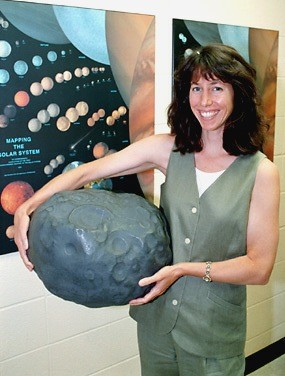Cornell researcher Beth Clark named by NASA to head research team for 2002 asteroid sample return mission
By David Brand
Beth E. Clark, a research associate in Cornell University's Department of Astronomy for the past three years, has been named by NASA to lead a research team for history's first asteroid sample return mission.
The 2002 joint mission with Japan will send a space vehicle to land on an asteroid, collect a sample of the surface and return it to Earth for analysis. This will be the first time that a space vehicle has attempted a landing on an asteroid.
Clark will lead the team that will develop the near infrared spectrometer to be carried aboard a miniature robotic rover vehicle that will be deployed by the spacecraft to explore a small area of the asteroid's surface. The spacecraft will shoot pellets into the surface to collect a few grams of surface samples, which it will transfer to the Earth return module.
In congratulating Clark on her appointment, Joseph Veverka, professor of astronomy and incoming chair of the Cornell Department of Astronomy, said the awarding of the contract follows "in the great tradition of Cornell's involvement with landers," beginning with the Apollo program, through the Viking program and currently with the Mars Pathfinder missions. Veverka was a member of the team that originally proposed the collaborative asteroid mission in 1997.
The mission, named MUSES-C (for Mu Space Engineering Spacecraft) will be the third (thus the "C") in a series of missions managed by the Japanese Institute of Space and Astronautical Science (ISAS) and NASA's Jet Propulsion Laboratory (JPL). The mission is scheduled to be launched from a Japanese M5 rocket in Kagoshima, Japan, in January 2002.
The target for the space mission is the asteroid 4660 Nereus, with the asteroid 1989 ML as a backup. Both asteroids come to within about 75 million miles of Earth. The space vehicle will arrive at the asteroid in April 2003, alight on the surface up to three times and collect surface samples for return to Earth in January 2006.
The asteroid mission will test a number of new technologies, including solar electric propulsion, autonomous landing and sampling and the hyperbolic re-entry of the sample return capsule to Earth.
The NASA MUSES-C group will develop the rover and support services for the mission. The rover, a tiny vehicle weighing about one kilogram (2.2 pounds), will be the smallest rover ever to fly on a space mission. It will carry several instruments to observe both in the visual and near-infrared wavelengths.
Clark says her team's job is to work with engineers at JPL to specify the science requirements in the development of a near-infrared spectrometer roughly the size of a hand-held calculator. It will take advantage of nanotechnology to build the smallest such instrument ever flown.
Clark, a researcher in the Cornell astronomy department's Center for Radiophysics and Space Research, obtained her B.S. in 1986 at the University of California at Berkeley and her Ph.D. in 1993 from the University of Hawaii. From 1993 to 1995, she was a Harlan J. Smith postdoctoral fellow at McDonald Observatory, the University of Texas. From 1995 to 1996, she was a National Science Foundation visiting professor at the Lunar and Planetary Laboratory, University of Arizona. She joined Cornell's astronomy department as a research associate in 1996.
For the past three years, Clark has been a convener and member of the scientific organizing committee of the seventh International Conference on Asteroids, Comets and Meteors, to be held at Cornell July 26-30.
She also has served on scientific review panels for the Hubble Space Telescope, the National Science Foundation and for NASA.
Media Contact
Get Cornell news delivered right to your inbox.
Subscribe